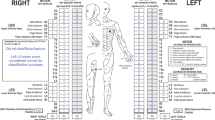Abstract
Study design
Online questionnaire.
Objectives
To identify the awareness, and current use, of the International Standards for the Assessment of Autonomic Function after SCI (ISAFSCI) and suggest necessary revisions.
Setting
An international collaboration of committee members.
Methods
A survey was drafted and consensus achieved among members of the International Standards Committee of the ASIA. The questionnaire was posted on SurveyMonkey for 2 months. A survey link was posted on the ASIA and ISCoS websites, and committee members circulated the survey to colleagues with the goal of obtaining a wide-spread international response.
Results
A total of 173 providers responded. About half (n = 84) of the respondents used the standards in some form. Forty-four percent (n = 72) felt they knew the difference between the standards and the data sets. Among 135 responses on the usefulness of the ISAFSCI, the bladder, bowel, and sexual function sections, and the heart rate, respiratory rate, blood pressure, and sudomotor sections for use in patients with tetraplegia were reported as most useful. Comments revealed that respondents would like more explanation regarding specific definitions of components of the standards, how/when to use the ISAFSCI, and how the ISAFSCI may assist in clinical care.
Conclusion
The ISAFSCI is used by a subset of SCI clinicians. Some find the standards useful, while others are unaware of the utility of the ISAFSCI to prevent morbidity and assist in documentation of autonomic recovery post SCI. Further clarification regarding the definition of various disorders, and how and why to use the ISAFSCI in the SCI population, is needed.
Similar content being viewed by others
Log in or create a free account to read this content
Gain free access to this article, as well as selected content from this journal and more on nature.com
or
References
Alexander MS, Biering-Sorensen F, Bodner D, Brackett NL, Cardenas, Charlifue S, et al. International standards to document remaining autonomic function after spinal cord injury. Spinal Cord. 2009;47:36–43.
Krassioukov A, Biering-Sorensen F, Donovan W, Kennelly M, Kirshblum S, Krogh K, et al. International standards to document remaining autonomic function after spinal cord injury. J Spinal Cord Med. 2012;35:201–10.
American Spinal Injury Association. International Standards to document remaining autonomic function after spinal cord injury. Atlanta, GA; 2012.
Kirshblum SC, Burns SP, Biering-Sorensen F, Donovan W, Graves DE, Jha A, et al. International standards for neurological classification of spinal cord injury (revised 2011). . J Spinal Cord Med. 2011;34:535–46.
American Spinal Injury Association. ASIA Learning Center. 2017. http://www.asiaspinalinjury.org/elearning/elearning.php. Accessed on 6 July 2017.
Round AM, Park SE, Walden K, Noonan VK, Townson AF, Krassioukov AV. An evaluation of the International Standards to document remaining Autonomic Function after Spinal Cord Injury: input from the international community. Spinal Cord. 2017;55:198–203.
Davidson R, Carlson M, Fallah N, Noonan V, Elliott S, Joseph J, et al. Inter-rater reliability of the International Standards to document Autonomic Function after SCI: ISAFSCI. J Neurotrauma. 2017;34:552–8.
Field-Fote EC, Yang JF, Basso DM, Gorrasini M. Supraspinal control predicts locomotor function and forecasts responsiveness to training after spinal cord injury. J Neurotrauma. 2017;34:1813–25.
Anderson K. Targeting recovery: Priorities of the spinal cord injury population. J Neurotrauma. 2004;21:1371–83.
Alexander MS, Conley C, Chen Y, McLain A. The use of the neurologic exam to predict awareness and control of lower urinary tract function post SCI. Spinal Cord. 2017;55:795; https://doi.org/10.1038/sc.2017.55.
Sipski ML, Alexander CJ, Gomez-Marin O. Effects of level and degree of spinal cord injury on male orgasm. Spinal Cord. 2006;44:798–804.
Sipski ML, Alexander CJ, Rosen R. Sexual arousal and orgasm in women: effects of spinal cord injury. Ann Neurol. 2001;49:35–44.
Marino RM, Schmidt-Read M, Kirshblum S, Dyson-Hudson TA, Tansey K, Morse LR, et al. Reliability and validity of S3 pressure sensation as an alternative to deep anal pressure in neurologic classification of persons with spinal cord injury. Arch Phys Med Rehabil. 2016;97:1642–6.
Squair JW, le NG, Noonan VK, Raina G, Krassioukov AV. Assessment of clinical adherence to the international autonomic standards following spinal cord injury. Spinal Cord. 2015;53:668–72.
Acknowledgements
We would like to acknowledge the American Spinal Injury Association and the International Spinal Cord Society for their financial and organizational support, and Fin Biering-Sørensen, Stacy Elliot, Michael Kennelly, Klaus Krogh, and Mehnert Ulrich for their expertise and scientific contribution to the development of the ISAFSCI survey.
Author information
Authors and Affiliations
Consortia
Corresponding author
Ethics declarations
Conflict of interest
The authors declare that they have no conflict of interest.
Additional information
Publisher's note: Springer Nature remains neutral with regard to jurisdictional claims in published maps and institutional affiliations.
Rights and permissions
About this article
Cite this article
Alexander, M., Wecht, J., Krassioukov, A. et al. Pulse article: Survey on the current usage of the International Standards for the Assessment of Autonomic Function after Spinal Cord Injury (ISAFSCI). Spinal Cord Ser Cases 3, 17100 (2017). https://doi.org/10.1038/s41394-017-0025-8
Received:
Revised:
Accepted:
Published:
DOI: https://doi.org/10.1038/s41394-017-0025-8
This article is cited by
-
What should be clarified when learning the International Standards to Document Remaining Autonomic Function after Spinal Cord Injury (ISAFSCI) among medical students
Spinal Cord Series and Cases (2021)
-
Awards and updates
Spinal Cord Series and Cases (2018)


